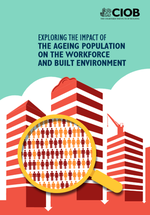Exploring the impact of the ageing population on the workforce and built environment
On 10th December 2015 the Chartered Institute of Building (CIOB) published: Exploring the impact of the ageing population on the workforce and built environment.
The percentage of people in the world aged 60 or over has increased from 9.2% in 1990 to 11.7% in 2013 and is forecast to reach 21.1% by 2050.
The CIOB report explores the effects of this ageing population on the construction industry and how the sector can adapt to meet some of the challenges it poses. It comes six years after a previous CIOB study which highlighted the crucial role the of built environment in improving the lives of older people.
The report is based on a survey of nearly 1,000 CIOB members. Its findings include:
- The built environment has a crucial role to play in terms of improving the lives of older people. However, awareness of the ageing population and its influence on the built environment has decreased since the previous report, despite changes in legislation.
- 19% of the construction workforce is set to retire in the next five to ten years. To be successful, construction needs greater investment to retain ageing workers’ knowledge and skills, where necessary, re-purposing job descriptions and overcoming stereotypes.
- 57% of respondents acknowledged it is ‘very important’ to retain ageing workers, but few adopt measures such as flexible working, succession planning, mid-life career reviews or retirement planning.
- More needs to be done to make use of ageing workers’ expertise and skills. Only 63% of respondents use mentoring as a regular feature in the workplace.
- Trade roles can give potential recruits the impression that the industry is dirty and dangerous.
It concludes that there is an increasing need to view the ageing population positively, utilising the ageing workforce better and redefining buildings.
Deputy Chief Executive of the CIOB Bridget Bartlett said: “… if construction is to meet the skills crisis it faces and fill the 224,000 vacancies needed by 2019, employers should look to take additional steps to overcome the skills shortages they incur by reaching out to older workers. There is a huge opportunity to showcase to both young and old members of the workforce that construction isn’t all hard hats and hi-vis and that off-site opportunities are aplenty. We demand technical skills as much as manual skills.
“Employers must also recognise the skills of their existing workers and put in measures such as flexible working, career reviews or even retirement planning to encourage longer working lives. As our own research tells us, skills shortages in construction are compounded by those entering the industry not being suitably qualified for the position. We should take this opportunity to use older workers to tap into their skills and knowledge and ensure they are passed onto the next generation.”
--CIOB
[edit] Related articles on Designing Buildings
- Accessibility in the built environment.
- Age diversity for social cohesion.
- Apprenticeships levy.
- Changing lifestyles.
- Construction skills shortage still stifling growth.
- Gangmaster.
- Inclusive design.
- Lifetime homes.
- Lifetime neighbourhoods.
- National Infrastructure Plan for Skills.
- Online mentoring can help professionals succeed.
- Perkins review.
- Protection for apprenticeships.
- Skills to build.
- Tackling the construction skills shortage.
Featured articles and news
Editor's broadbrush view on forms of electrical heating in context.
The pace of heating change; BSRIA market intelligence
Electric Dreams, Boiler Realities.
New President of ECA announced
Ruth Devine MBE becomes the 112th President of the Electrical Contractors Association.
New CIAT Professional Standards Competency Framework
Supercedes the 2019 Professional Standards Framework from 1 May 2025.
Difficult Sites: Architecture Against the Odds
Free exhibition at the RIBA Architecture Gallery until 31 May.
PPN 021: Payment Spot Checks in Public Sub-Contracts
Published following consultation and influence from ECA.
Designing Buildings reaches 20,000 articles
We take a look back at some of the stranger contributions.
Lessons learned from other industries.
The Buildings of the Malting Industry. Book review.
Conserving places with climate resilience in mind.
Combating burnout.
The 5 elements of seiri, seiton, seiso, seiketsu and shitsuke.
Shading for housing, a design guide
A look back at embedding a new culture of shading.
The Architectural Technology Awards
The AT Awards 2025 are open for entries!
ECA Blueprint for Electrification
The 'mosaic of interconnected challenges' and how to deliver the UK’s Transition to Clean Power.
Grenfell Tower Principal Contractor Award notice
Tower repair and maintenance contractor announced as demolition contractor.
























